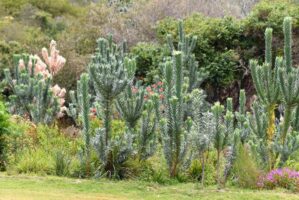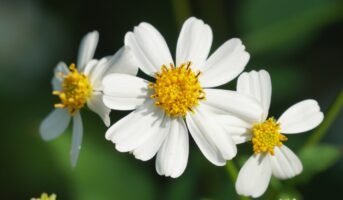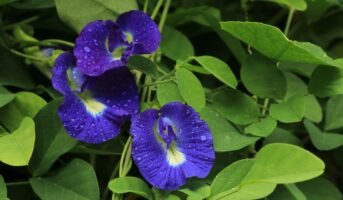Rajnigandha or Nishigandha flowers, known as Tuberose in English, are fragrant flowers that grow as clusters of large, pristine, white blooms. Popularly used for wedding decorations and auspicious events, the flowers can add magnificence to any outdoor space and are easily found at any florist. However, it is easy to grow the plant in your home garden. Follow this guide on how to grow Rajnigandha.
See also: 21 best flowers for your garden
Rajnigandha Flower: Quick facts
| Plant name | Tuberose, Rajnigandha or Nishigandha |
| Scientific name | Agave Amica |
| Family | Asparagaceae |
| Found in | Mexico |
| Flower | Bulbous, white flowers |
| Flower blooming season | Summer and autumn |
| Benefits | Ornamental purposes, used in making perfumes and cosmetic products |
- The flowers, which bloom throughout the year, have waxy, star-shaped florets.
- The plant reaches up to a maximum height of 2-3
Rajnigandha flower benefits
Rajnigandha plant is commercially grown and has applications in perfume manufacturing, extraction of essential oil and making artistic garlands, bouquets and floral ornaments.
Perfumery
The essential oil of the flower, which has a strong fragrance, is mainly used in high-grade perfumes. The single-petal varieties of flowers are more fragrant than the double-petal ones. The single-petal varieties are used for the extraction of essential oil and making garlands, whereas the double-petal varieties are used for ornamental purposes.
Aromatherapy
The soothing fragrance is effective in aromatherapy and can relax the nerves.
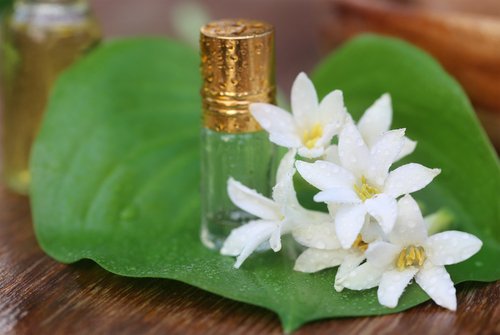
See also: All about garden roses
Floral ornaments
The elongated flower spikes are used as cut flowers and displayed in vases for interior decorations.
Medicinal use
Rajnigandha or Nishigandha flower is used in Ayurvedic medicines, dental creams and mouthwash. Further, the flowers are mixed with stimulants or sedatives in beverages made from chocolate.
How to grow the Rajnigandha flower?
Tuberose flower bulbs are grown outdoors. You can plant it in early spring as the flowering season is during mid to late summer or around three to four months after planting. Allow the plant to rest for some months before starting the next growing cycle.
Landscape planting
Identify a place with well-drained soil for Rajnigandha. Dig holes and place the bulb clumps 8-10 inches apart with 2-3 inches of soil over the top. Make sure the area gets ample sunlight.
Container planting
Use well-drained and good-quality potting soil and put it in a planter or container with sufficient drainage holes. Dig holes and place the bulb clumps 8-10 inches apart with 2-3 inches of soil over the top.
Rajnigandha flower care
Watering
During the peak growing season, the plant must be provided with adequate water.
Fertiliser
The plant needs a balanced fertiliser every month when actively growing. Use any organic fertiliser. Choose an 8-8-8 fertiliser of potassium, nitrogen and phosphorus.
Sunlight
The plant should receive full sun. However, you can place the plant in a spot with light shade in very hot and dry regions.
Climate
Rajnigandha flowering plants are ideally grown in tropical, subtropical or temperate climates. The plant prefers open and sunny areas. They are commercially cultivated in warm, humid areas with an average temperature ranging from 20-30 degrees Celsius.
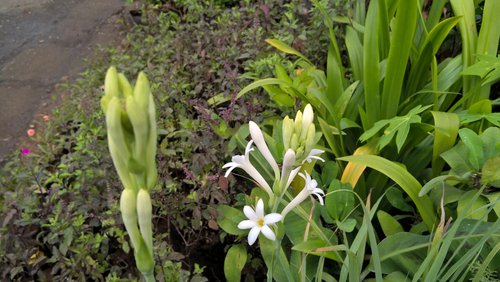
Rajnigandha propagation
Tuberose plants are propagated using bulbs, bulblets and seeds. Multiplication is also done through bulb segments and in-vitro micropropagation from scale stem sections.
Rajnigandha flower varieties
Rajnigandha Flowers come in different varieties based on the number of petal rows.
- Single: Shringar is a tuberose hybrid that is developed from a cross between single and double-petal varieties and features pinkish flower buds. Prajwal is another hybrid variety of the Rajnigandha flower. Single Mexican and Arka Nirantara are other single varieties of the plant.
- Semi-double: This type of Rajnigandha flower has more than three rows of corolla segments.
- Double: This double-petaled variety produces more flowers per spike. Some examples are Suvasini, Vaibhav and Pearl Double.
- Variegated: These varieties come as streaked leaf forms and have silvery white or golden yellow streaks on the leaves. Rajat Rekha and Swarna Rekha are examples of this category.
Rajnigandha plant harvesting
The flowering of the Tuberose plant begins around three months after planting. The flowering season starts in July and continues through the year. The peak flowering time is around August-September. Harvesting is carried out by cutting spikes from the plant’s base. Single flowers are also harvested as they bloom.
Rajnigandha plant pests and diseases
Gardeners must always be careful about pest attacks. The Tuberose plant is less susceptible to pest attacks or diseases. Yet, care must be taken against common insects and pests such as grasshoppers, weevils, thrips, aphids, bud borer, red spider mites and rodents.
FAQs
What is the Rajnigandha flower called in English?
The Rajnigandha flower is known as Tuberose in English.
Does the Rajnigandha flower have a fragrance?
The Rajnigandha flower has a sweet, honey-like fragrance.
How to store Rajnigandha flowers?
Fresh Rajnigandha flowers can be stored for around five days in a cool place with a temperature of 10 degrees Celsius.
Harini is a content management professional with over 12 years of experience. She has contributed articles for various domains, including real estate, finance, health and travel insurance and e-governance. She has in-depth experience in writing well-researched articles on property trends, infrastructure, taxation, real estate projects and related topics. A Bachelor of Science with Honours in Physics, Harini prefers reading motivational books and keeping abreast of the latest developments in the real estate sector.


